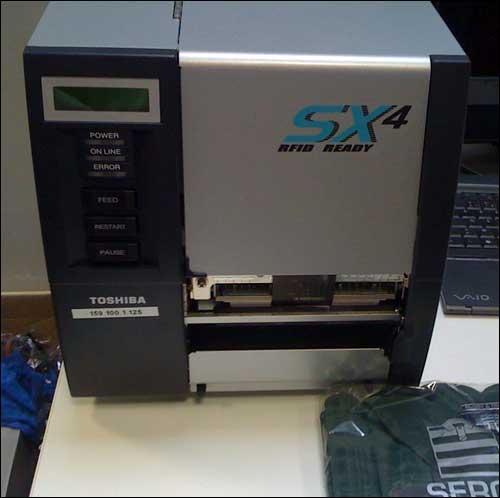Serge Blanco, a maker of high-end clothing well-known in France, is employing EPC Gen 2 RFID tags to receive incoming goods at its distribution center (DC) in Toulouse. The application, which became operational in the middle of this year, has allowed the firm’s employees to spend more time inspecting the quality of goods received than it was able to previously, according to Mathieu Pradier, the company’s finance and IT director.
When Serge Blanco places a garment order with a supplier, it prints bar codes on a corresponding quantity of RFID hangtags, then sends those tags to the factory where the garments are made. At the plant, workers attach the paper hangtags to garments at the production site, and ship them to Serge Blanco’s DC. Most tagged garments are received folded in boxes, though a few, such as coats and jackets, arrive on hangers. The company estimates it will use one million RFID hangtags per year.
When the boxes of tagged goods arrive, an employee moves them through a tunnel reader that interrogates the tags, thereby identifying the garments. The computer system compares the box’s contents (as determined via RFID) with an electronic packing list for that order. If the order arrives as expected, a green light gives workers the okay to proceed. If not, a red light shines, and the staff must determine the cause of the mismatch.
The workers then move the tagged items to a picking area in the DC, which is outfitted with six RFID readers installed beneath tables. The staff picks products from the large boxes, and creates small packages for retail stores served by the company. Serge Blanco has approximately 320 retail stores and shops throughout the country. The under-table readers interrogate the tags on garments in the boxes, and the system confirms the picking’s accuracy. Packages are then shipped out to individual customers.
The process for accounting for hanging items is similar, but relies on a wireless handheld RFID reader that Pradier says resembles a tennis racket. Workers use the device to read tagged items in hanging boxes by moving the reader around the outside of the box. This is done when goods are received, and again after they are picked and ready to send to retail stores.
Tagsys provided all readers for Serge Blanco’s RFID system, as well as the RFID tags embedded within the paper hangtags. Serge Blanco produces the hangtags on four Toshiba RFID printer encoders. If items are received untagged from suppliers, Serge Blanco performs the tagging itself. However, Pradier says, most goods arrive already tagged.
The tunnel readers can process 18,000 items per hour, Tagsys reports, with a read accuracy of 99 percent. According to Pradier, the system is a huge time-saver. “Before,” he says, “we had to open individual boxes and read the bar codes on items one by one. We needed 10 people to receive 20,000 garments. Now, we need two people for 35,000.” Consequently, he says, Serge Blanco “moved many employees into customer service or quality-control jobs.”
Pradier estimates that the system, installed with the help of Tagsys, cost the company €150,000 ($225,000). The firm’s business plan projects that the system will pay for itself within three years, though Pradier believes Serge Blanco will recoup its costs sooner than that.
At present, Serge Blanco does not identify items at the dock door when they are shipped to stores. In 2011, however, the company plans to add this functionality, along with the ability to interrogate garments’ RFID tags at stores, in order to ease the inventory process.
Serge Blanco does not notify store customers regarding the garments’ RFID tags, because clerks are instructed to cut them off at the point of sale. The clerks retain the tags for one month, in case any outfits are returned.



